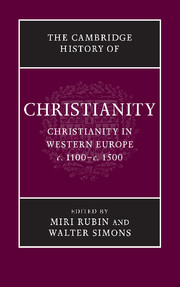Book contents
- Frontmatter
- Introduction
- PART I INSTITUTIONS AND CHANGE: 1100–1200
- PART II FORGING A CHRISTIAN WORLD, 1200–1300
- 5 The theological framework
- 6 The legal underpinnings
- 7 Material support I: parishes
- 8 Material support II: religious orders
- 9 The Word and its diffusion
- PART III THE ERECTION OF BOUNDARIES
- PART IV SHAPES OF A CHRISTIAN WORLD
- PART V CHRISTIAN LIFE IN MOVEMENT
- PART VI THE CHALLENGES TO A CHRISTIAN SOCIETY
- PART VII REFORM AND RENEWAL
- Select bibliography
- Index
- Map 1 Western Europe c. 1100 – c. 1500
- Map 2 Universities of Europe
- References
7 - Material support I: parishes
from PART II - FORGING A CHRISTIAN WORLD, 1200–1300
Published online by Cambridge University Press: 28 March 2010
- Frontmatter
- Introduction
- PART I INSTITUTIONS AND CHANGE: 1100–1200
- PART II FORGING A CHRISTIAN WORLD, 1200–1300
- 5 The theological framework
- 6 The legal underpinnings
- 7 Material support I: parishes
- 8 Material support II: religious orders
- 9 The Word and its diffusion
- PART III THE ERECTION OF BOUNDARIES
- PART IV SHAPES OF A CHRISTIAN WORLD
- PART V CHRISTIAN LIFE IN MOVEMENT
- PART VI THE CHALLENGES TO A CHRISTIAN SOCIETY
- PART VII REFORM AND RENEWAL
- Select bibliography
- Index
- Map 1 Western Europe c. 1100 – c. 1500
- Map 2 Universities of Europe
- References
Summary
The thirteenth century saw the triumph of the Gothic style in architecture in the building of great cathedrals all across Europe, a phenomenon much celebrated by modern art historians. ‘The Gothic Image’ seems to capture the spirit of the ‘Age of Cathedrals’ with its intellectual ambitions, artistic development and the craftsmanship available in twelfth- and thirteenth-century Europe. But who paid for it all? The material support offered to ecclesiastical institutions is probably most often explored by historians with regard to aristocratic patronage and to donations made in connection with the preparations for a ‘Good Death’. Yet the perpetual daily provision of ecclesiastical services to the community, the sustenance and education of the church personnel as well as the construction, daily running and repair of complex and expensive buildings required more and regular provision. From its origins, the church depended on a robust economic foundation and persistent support from the community in order to guarantee its services; this need led to the establishment of a series of practices and rules for both obligatory and voluntary contributions, thus creating a complicated framework of links and interdependences between the laity on the one hand, and the church’s many institutions, from cathedrals and parish churches to monasteries or hospitals, on the other.
Keywords
- Type
- Chapter
- Information
- The Cambridge History of Christianity , pp. 99 - 106Publisher: Cambridge University PressPrint publication year: 2009



